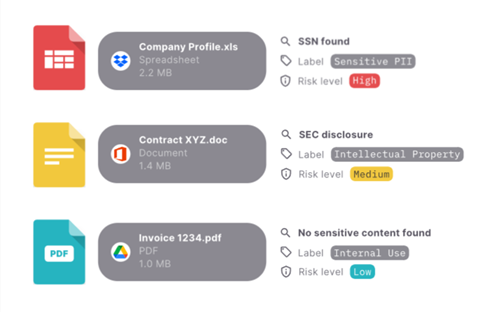Data Classification Challenges
Organizations of all sizes have data complexity, involving many disparate productivity solutions and data storage locations. And the longer the company is in business and the bigger it gets, the more complex this data environment becomes. That is why so many enterprises may find themselves with challenges when it comes to data discovery and classification.
Mergers and acquisitions can leave data classification a jumble, as organizations have their own unique data classification policies and procedures. On top of organizational differences, each different business unit may have legitimate reasons for different classification policies even within the same organization. Fundamentally, making sense of everything and providing holistic data classification and governance is more than IT can handle with written policies. They need solutions that can help them sort out their data classification challenges and automatically remediate them, especially to ensure they’re staying on top of data risk management. Because in the end, the real issue is: poor data classification leads to increased data risk from breach and non-compliance.
When Data Classification Goes Astray
It’s a classic story. IT sets great rules for data classification, the business units agree to them, then immediately begin workarounds to improve efficiency. It’s not done with malice. People are just trying to complete their jobs as quickly as possible.
Let’s take a simple scenario of a hiring manager interviewing candidates for a job opening. HR might be well-trained in classifying resumes and storing them appropriately, but the hiring manager (in a different business unit) decides to save the resumes on their hard drive. Those resumes have personal information on them that could be a violation of regulations like the California Consumer Privacy Act if not secured properly.
On top of scenarios like this, employees make mistakes. They forget policies. Or they intentionally work around them to share data with third parties because they need to finish their work, without realizing the risk of that decision. All of this results in misclassified data and a ton of unstructured data that IT might not even know about. Herein lies the biggest data classification challenges for companies looking to protect themselves. How can IT properly secure their data if they don’t know what needs securing?
How DryvIQ Bridges Classification Differences
DryvIQ provides an AI-powered enterprise data management platform that can look into unstructured data to identify it and automate classification. The DryvIQ platform has pre-trained AI that reviews and compares data to known data types using advanced pattern matching. The first level of inspection identifies the type of file such as resume, W-2, invoice, etc. It has a database of over 5,000 standard government forms that it can compare and identify as well as learn from an organization’s unique forms and file types.
The next level of classification involves looking into the file to identify foreign languages and PII such as names, ages, addresses, birthdates, phone numbers, social security numbers, banking information, and much more. When DryvIQ identifies this information—especially sensitive information—it can automatically assign tags for what it has found and flags it to indicate a qualitative risk level for that data.

Most importantly, the DryvIQ platform can apply metadata, document type, or other identifying tags or labels to unstructured data. This includes editing the tags and classification of files where the labels aren’t matching up with the information contained within. This completely solves the problem of no labels or the wrong labels coming from the disparate business units.
A Case Study on Getting Departments on the Same Data Classification Page
Melissa Chapman, DryvIQ’s Director of Product Management, recently shared how an enterprise with many disparate business units used the DryvIQ platform to solve their data classification challenges. Chapman explained their complexity, “They have a wide range of organizations that actually touch their data. And not just different departments, but different pieces of different departments that all do something very different. All potentially, are classifying data very differently and might not all be following the policies that the company has set.”
The enterprise asked DryvIQ to help unravel this complexity. “The DryvIQ platform is helping them to pinpoint each of those divisions in each of those departments and has the flexibility to give each of them the rules that work for that particular subset of data that they want to classify,” stated Chapman. Once the rules were active, Chapman noted how the power of the automation handled the large scale of data. “As the policies are run across the data, sources actually can move data to the locations and help them organize across the berth of the organization.”
The value of this data classification clean up according to Chapman is a gaining true picture of data risk. “Being able to understand what they have, classify it appropriately, and get a clear picture of risk is such a game-changer for them. Especially since our DryvIQ platform revealed additional risk in unstructured data that they didn’t know about. Now they can organize that data quite a bit better and take measures to secure their data and mitigate risk.”
Proper Data Classification Automates Risk Mitigation
The biggest risk in data protection is the unknown. When organizations can gain visibility into their unstructured data and properly classify it, this is so powerful for risk mitigation. It puts IT back in control for taking action to properly flag, move, quarantine, or even delete sensitive data appropriately. And that’s what DryvIQ does for enterprise data management. It removes human error and manual labor while putting IT back in control of their data across all environments. The end result is more confidence in cyber resiliency and lower financial risk from your data.
And instead of being frustrated about the differences across business units, IT can embrace those differences while still properly managing data and data risk. And that is one less major headache for IT!
Want to learn more about new ways to automate data risk management? Get the deep dive here.
Gain a deeper understanding of data risk, how it is assessed, how organizations can continuously manage data risk, and what this new era of data management means for IT teams and the business by clicking here.

